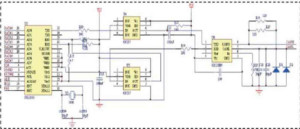(1) TTL level interface:
This interface type is basically a commonplace, from the university to learn analog circuits, digital circuits began, for the general circuit design, TTL level interface basically can not get off! Its speed is generally limited to within 30MHz, which is due to BJT input of the existence of several pF input capacitor (constitute an LPF), the input signal exceeds a certain frequency, then the signal will be “lost.” Its driving ability is generally up to dozens of milliamperes. The normal work of the signal voltage is generally high, if it and the signal voltage lower ECL circuit close to produce more obvious crosstalk problem.
(2) CMOS level interface:
We are no stranger to it, but also often deal with it, and some of the semiconductor features on the CMOS here do not have long-winded. Many people know that under normal circumstances CMOS power consumption and anti-jamming capability is far superior to TTL. However, little is known, in the high conversion frequency, the CMOS series is actually more power than the TTL, as to why this, please go to the semiconductor physics theory bar. Since the CMOS operating voltage is now very small, and some FPGA core voltage is even close to 1.5V, so that the noise margin between the level is much smaller than the TTL, so more aggravated due to voltage fluctuations caused by Signal is wrong. As we all know, CMOS circuit input impedance is very high, therefore, its coupling capacitance capacity can be small, without the need to use a large electrolytic capacitor. As the CMOS circuit is usually weak drive capability, it must first TTL conversion and then drive ECL circuit. In addition, the design of CMOS interface circuit, we should pay attention to avoid capacitive overload, otherwise it will make the rise time becomes slower, and drive device power will increase (because the capacitive load does not consume power).
(3) ECL level interface:
This is the old friend of the computer system! Because it’s running “fast” and can even go to hundreds of MHz! This is because the internal BJT inside the ECL is not in a saturated state, so that it can be reduced BJT conduction and cut-off time, the speed of work can naturally put up. But it is to pay the price! Its fatal injury: power consumption! It caused the issue of EMI is also worth considering, anti-jamming ability is not much to go, if who can compromise these two points Factor, then he (she) on the fortune. It should be noted that the general ECL IC is the need for negative power supply, that is, its output voltage is negative, then you need a special level of the mobile circuit.
(4) RS-232 level interface:
Playing electronic technology basically no one who does not know it (unless he or she is only the electronics technician professional “layman”). It is low-speed serial communication interface standard, it should be noted that its level standard a bit “abnormal”: high level of -12V, while the low level of +12 V. So, when we try to communicate with the peripherals through the computer, a level conversion chip MAX232 naturally is indispensable. But we have to be aware of some of its shortcomings, such as data transmission speed is still relatively slow, transmission distance is also short and so on.
(5) Differential Balanced Level Interface:
It is a pair of terminals A and B relative to the output voltage (uA-uB) to represent the signal, under normal circumstances, the differential signal in the signal transmission through a complex noise environment, resulting in both lines are generated Basically the same amount of noise, and at the receiving end will be the energy of the noise to offset, so it can achieve more distant, higher rate of transmission. Industrial commonly used RS-485 interface is used in differential transmission, it has a good resistance to common mode interference.
(6) Optical isolation interface:
Optoelectronic coupling is the optical signal as the medium to achieve the coupling and transmission of electrical signals, and its “benefits” is able to achieve electrical isolation, so it has excellent anti-jamming capability. In the circuit operating frequency is very high conditions, the basic only high-speed optical isolation interface circuit to meet the needs of data transmission. In order to achieve high voltage and high current control, we must design and use optical isolation interface circuit to connect these low-level, low-current TTL or CMOS circuits as described above, because the optical isolation interface input circuit and output circuit Can withstand thousands of volts of high pressure, enough to meet the general application. In addition, the optical isolation interface input and output parts must be independent of the power supply, otherwise there is an electrical connection, it is not called isolation.
(7) Coil coupling interface:
Its electrical isolation characteristics are good, but the allowed signal bandwidth is limited. For example, transformer coupling, its power transmission efficiency is very high, the output power is basically close to its input power, therefore, for a step-up transformer, it can have a higher output voltage, but can only give a lower Current. In addition, the high frequency and low frequency characteristics of the transformer are not optimistic, but its biggest feature is that the impedance conversion can be achieved, when the match was time, the load can get enough power, therefore, the transformer coupling interface in the power amplifier circuit design Very “delicious”.

